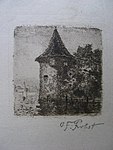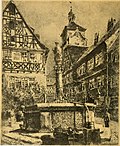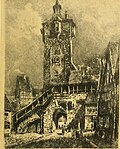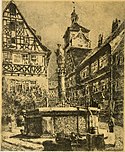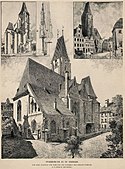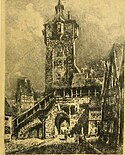Otto Ferdinand Probst
Otto Ferdinand Probst (* 13. Mai 1865 in Breslau; † 1923 an der Ostsee) war ein deutscher Grafiker und Architekt.
Leben und Wirken
Er studierte an der Kunstschule in Breslau und später an der Kunstakademie (1902)[1] und der Technischen Hochschule in München. Er war 1900 als Oberlehrer an der Königlichen Baugewerkschule in Breslau tätig.[2]
Er veröffentlichte ein Buch mit Ansichten von Augsburg und um 1900 eine Sammlung seiner Zeichnungen aus den Jahren 1898 bis 1899 Breslaus malerische Architekturen, in der architektonisch interessante Bauten aus Breslau mit Bleistift und Feder sowie Fotografien abgebildet sind. Er stellte hauptsächlich Radierungen her, insbesondere Stadtansichten (u. a. Lindau, München, Nürnberg, Rothenburg ob der Tauber) sowie mehrere Landschaftsansichten des Riesengebirges.
Veröffentlichungen
- Augsburg in Bild und Wort. Eine Auswahl von Architecturen und malerischen Städtebildern. 70 Tafeln Herausgegeben von O. F. Probst und August Mülleger. Text von Th. Ruess. Lampart & Comp., Augsburg [um 1896].
- Breslaus malerische Architekturen. Begleitender Text von Hans Lutsch, in 10 Lieferungen (1899–1900), Druck bei Johannes Beyer, Zittau, Selbstverlag, Breslau 1900 (dbc.wroc.pl).
- Buchanzeige: Breslaus malerische Architekturen. In: Centralblatt der Bauverwaltung. 20. Jahrgang, Nr. 25, 31. März 1900, S. 153–154 (Abbildungen, Textarchiv – Internet Archive).
- Buchanzeige: Breslaus malerische Architekturen. In: Centralblatt der Bauverwaltung. 20. Jahrgang, Nr. 79, 6. Oktober 1900, S. 483–484 (Abbildung, Textarchiv – Internet Archive).
- Beispiele für Radierungen
Literatur
- Probst, Otto Ferdinand. In: Hans Wolfgang Singer (Hrsg.): Allgemeines Künstler-Lexicon. Leben und Werke der berühmtesten bildenden Künstler. Vorbereitet von Hermann Alexander Müller. Band 6: Zweiter Nachtrag mit Berichtigungen. Literarische Anstalt, Rütten & Loening, Frankfurt a. M. 1922, S. 226 (Textarchiv – Internet Archive).
- Probst, Otto Ferdinand. In: Hans Vollmer (Hrsg.): Allgemeines Lexikon der Bildenden Künstler von der Antike bis zur Gegenwart. Begründet von Ulrich Thieme und Felix Becker. Band 27: Piermaria–Ramsdell. E. A. Seemann, Leipzig 1933, S. 412.
Anmerkungen
- ↑ Eintrag in der Matrikeldatenbank: Probst, Otto, aus Kolberg, Alter 37 Jahre, Eintritt 5. April 1902, Radierklasse.
- ↑ So auf dem Titelblatt von Breslaus malerische Architekturen. 1900; dort auch als Architekt bezeichnet.
Weblinks
| Personendaten | |
|---|---|
| NAME | Probst, Otto Ferdinand |
| ALTERNATIVNAMEN | Probst, Otto F.; Probst, O. F. |
| KURZBESCHREIBUNG | deutscher Grafiker und Architekt |
| GEBURTSDATUM | 13. Mai 1865 |
| GEBURTSORT | Breslau |
| STERBEDATUM | 1923 |
Auf dieser Seite verwendete Medien
Autor/Urheber: Internet Archive Book Images, Lizenz: No restrictions
Identifier: romanticgermany00scha (find matches)
Title: Romantic Germany
Year: 1910 (1910s)
Authors: Schauffler, Robert Haven, 1879-1964
Subjects: Cities and towns -- Germany Germany -- Description and travel
Publisher: New York : The Century Co.
Contributing Library: University of California Libraries
Digitizing Sponsor: MSN
View Book Page: Book Viewer
About This Book: Catalog Entry
View All Images: All Images From Book
Click here to view book online to see this illustration in context in a browseable online version of this book.
Text Appearing Before Image:
tivating corner oriel. This building, with its bitof walled garden, was once the Jewish dance-house.Old Jewish baths are still to be seen in the cellars. From the Wiirzburg Gate, as from so many of theothers, there looks down a stone face, probably theportrait of a would-be traitor; and inside of the arch-way a mysterious profile is roughly chiseled—a pro-file about which one hears all sorts of contradictoryreports. This northern part of the town wall is the best pre-served, for it was built according to the theories ofVitruvius, and is the foremost example of its kind.On its broad top the maidens dance after the festivalplay. Here my friends, two young American paint-ers, once gave their memorable Fourth of July cele-bration, and, after the fireworks, were carried homeon the shoulders of the delighted inhabitants, anevent that will doubtless be talked of in Rothenburgfor generations. I walked to the Klingen Gate along the gallery.This passage has never been much used except for 376
Text Appearing After Image:
FOUNTAIN IN THU KAIEI.I.EN-PLATZ THE CITY OF DREAMS defense, but its deeply worn pavement is eloquent ofthe towns martial history. I found it the haunt ofrope-makers, with hemp flying from their girdles andlodged in their flaxen whiskers. Many of the loop-holes were walled up, but through the open ones Icaught rare little vignettes of flowering moat and apleasant countryside in bloom. The Klingen Gate, with its side turrets, rivals theStoberlein Tower, with its corner ones, for the dis-tinction of being Rothenburgs most beautiful tower.From the wall here a dark stairway winds down intothe little Church of the Shepherds. Some centuries ago the local Jews were believed tohave conspired to poison the fountains, murder thewatch, and make Rothenburg in very deed into a newJerusalem. But the shepherds of the neighborhooddiscovered and published the plot. As a reward, theywere allowed, until late in the eighteenth century, tohold an annual festival in honor of this event. Itbegan with a serv
Note About Images
Otto Ferdinand Probst: Lindau, Blick auf den Pulverturm vom Wasser aus, Radierung, Platte 5.3 x 5.2 cm
Autor/Urheber: Internet Archive Book Images, Lizenz: No restrictions
Identifier: romanticgermany00scha (find matches)
Title: Romantic Germany
Year: 1910 (1910s)
Authors: Schauffler, Robert Haven, 1879-1964
Subjects: Cities and towns -- Germany Germany -- Description and travel
Publisher: New York : The Century Co.
Contributing Library: University of California Libraries
Digitizing Sponsor: MSN
View Book Page: Book Viewer
About This Book: Catalog Entry
View All Images: All Images From Book
Click here to view book online to see this illustration in context in a browseable online version of this book.
Text Appearing Before Image:
forin the museum hard by is still to be seen the hugetankard which Burgomaster Nusch drained at adraught to save the lives of the town councilors fromthe infuriated Tilly. But I am not rehearsing thefamous story of the Meistertrunk, for two reasons.In the first place, it has already been told a thousandtimes. In the second place, it was probably manu-factured out of whole cloth in the eighteenth century. Next door to the museum, on the Apotheke, acharming oriel window with a green-and-red-tiledroof serves as background for the fountain and asbaldachin for an old saint. Happy is he who is allowed to visit the courtyardbehind this Apotheke, where the Rathaus tower peersdown upon its riot of roofs, its ivied walls, and itslatticed gallery, reminiscent of the best courtyardgalleries in Nuremberg. From all sides of the market-place run alluringstreets and alleys which, taking a line from the bogusinstruments of torture in the Straf Tower, pull onein seven different directions at once. 866
Text Appearing After Image:
COURT Ol- Tlllv A1()TI11:KE THE CITY OF DREAMS The Herren-Gasse pulled me the hardest, a streetrunning to the site of the red castle that gave Roth-enburg its name and was destroyed by a fourteenth-century earthquake. Here the patricians lived, andthe way is lined with courtly houses, many of themGothic. In the Herren-Gasse I found a number ofwell-preserved interiors, with good old paneled ceil-ings and stucco-work. In front were interestingportals with sculptured coats of arms, and in therear, idyllic little courts or wooded gardens. Nimi-ber 2 proved to be a medieval bake-shop, and nearby was a time-honored wine-house with separaterooms for patrician and plebeian. Behind a lofty stepped* gable some one wasplaying a rondo by Mozart on a spinet-like piano,and the eighteenth-century music sounded as radicalin that older atmosphere as would a Debussy tone-poem heard in the baroque quarter of Leipsic. Beneath the Castle Gate, over a bridge, and be-tween friendly, dunce-capped gate-houses
Note About Images
ehemalige evangelische Barbarakirche in Breslau
Autor/Urheber: Internet Archive Book Images, Lizenz: No restrictions
Otto Ferdinand Probst - The Klingen-Gate Tower in Rothenburg ob der Tauber, c. 1909
Identifier: romanticgermany00scha (find matches)
Title: Romantic Germany
Year: 1910 (1910s)
Authors: Schauffler, Robert Haven, 1879-1964
Subjects: Cities and towns -- Germany Germany -- Description and travel
Publisher: New York : The Century Co.
Contributing Library: University of California Libraries
Digitizing Sponsor: MSN
View Book Page: Book Viewer
About This Book: Catalog Entry
View All Images: All Images From Book
Click here to view book online to see this illustration in context in a browseable online version of this book.
Text Appearing Before Image:
under the Church of St. James. It is a fit set-ting for the legend of The Poor Soul of Rothenburg.In olden days the burghers did not believe much inthe devil, which angered that personage. Once upona time when a peasant was passing under this arch-way the devil caught him suddenly and hurled himagainst the vaulting with great force. The poorbody fell down again at once, but the poor soul re-mained sticking to the stones. You may see it thereto-day. It is sort of brown, writes the chron-icler, with black spots. On the southern roof of the church is a recliningfigure which recalls another legend. In building thetwo towers the architect let his pupil try his hand atone of them. And when he saw how much his pupilstower outshone his, he leaped to his death from thescaffolding. The pupil then carved his masters por-trait on the roof. The architecture of the interior is rather more coldand austere than one would expect of Rothenburgsprincipal church; but there is a compensatory richness 380
Text Appearing After Image:
i THE KI,1NGEX-GATE TOWER THE CITY OF DREAMS of imagination in the altars by Herlin and Riemen-schneider and in the blaze of color that pours throughthe fifteenth-century windows. Here also is a touchof that naivete which is so enjoyable in the localhouse inscriptions. For the eastern windows repre-sent the Fall of the Manna as a rain of South-Ger-man rolls and pretzels. Of all the alluring ways beckoning out of the mar-ket-place, one of the most alluring to me was theSchmied-Gasse, with its view of that notable Renais-sance dwelling, the Architects House. The caryatidsbetween the windows with their reminiscence of theErechtheimi, and the stately portal and gable, bringout vividly the classical dignity and poise of theperiod, while the courtyard is teeming with Rothen-burgs unique charm. There you may loll at tablesmade of old millstones, with moss and flowers grow-ing from the hole in the center, and sip your coffeefrom earthenware cups of the quaint local pattern.That is the place t
Note About Images


